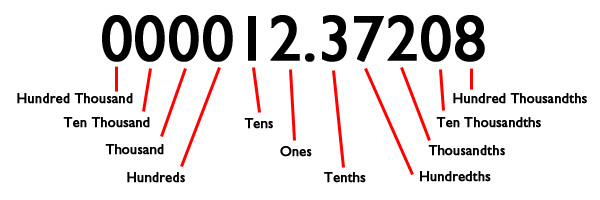
Grade 6 | Lesson 1
Dean of Students: dean@theschools.com
Tech Services: tech@theschools.com

Grade 6 | Lesson 1
Dean of Students: dean@theschools.com
Tech Services: tech@theschools.com
Mathematics
Lesson Overview
6th Grade Mathematics
• Place Value
• Estimation
![]()
6th Grade Mathematics
Welcome to 6th grade math! As has been the case before and will be until you're done studying mathematics (in high school or college) it's a field of continuous building. Layer upon layer upon layer will slowly give you all the tools you need to both understand math conceptually, but also to use it in any and all applicable real-world situations. Your first lessons will be a review focusing on a variety of topics you've surely covered to some degree in the past.
Place Value
Let's take a look at a concept that will come up repeatedly into higher level math: place value. Let's examine place value using the examples of trillions and hundred thousandths:
Trillions
The period, or major unit of value, after billions is trillions. 10 hundred billions or 1000 billions equal 1 trillion. You read the number 314,506,000,000,000 as three hundred fourteen trillion, five hundred six billion.
Instead of writing the zeros in large numbers, we often use a shortened word form.
586,000,000,000 can be written as 586 billion.
3,700,000 can be written as 3.7 million (700,000 is 7 tenths of a million).
2,998,810,000,000 can be written as 2 trillion, 998 billion, 810 million.
Hundred Thousandths
When a number is not a whole number and there is a decimal, the fifth place to the right of the decimal point is the hundred thousandths’ place.
You read 12.37208 as"twelve and thirty seven thousand, two hundred eight hundred thousandths. Notice that you read the decimal places in terms of the smallest decimal place value.
You can also read 12.37208 as twelve point three seven two zero eight.
This image depicts the place to the left and right of the decimal and there titles:

The place values to the right of the ones’ place follow the same pattern as the place values to the left of the ones'’ place. Just as the place to the left of the ten thousands’ place is the hundred thousands’ place, so the place to the right of the ten thousandths’ place is the hundred thousandths’ place. Each place is one tenth the size of the place to its left. For example, there are 10 thousandths in 1 hundredth. You have to add 1 thousandth ten times to 3.67 to make it 3.68.
Decimals are sometimes written in short word form. 0.9612 can be written as nine thousand, six hundred twelve ten thousandths or 9612 ten thousandths.
Estimation
When you estimate the answer to a problem, you can round in different ways. How you round will determine how precise or close to the actual answer your estimate is.
To estimate the sum of 12,422 + 36,367, you can round the addends to the nearest ten thousand, thousand, or hundred.
Rounded to the nearest ten thousand:
10,000 + 40,000 = 50,000
Rounded to the nearest thousand:
12,000 + 36,000 = 48,000
Rounded to the nearest hundred:
12,400 + 36,400 = 48,800
Not rounded (actual sum:
12,422 + 36,367 = 48,789
The smaller the place value you round to, the more precise your estimate will be.
Whenever you can, decide whether your estimate is greater or less than the actual answer. When we are working with decimals or mixed numbers, we usually estimate by rounding numbers to the nearest whole number.
Here are another few examples that we'll estimate together:
364.232 • 8.427
364 • 8 = 2912
Because both numbers were rounded down, you know that the actual product is greater than 2912.
763 • 218
800 • 200 = 160,000
Because the numbers were rounded in different directions, it is hard to tell whether the actual product is greater or less than 160,000.
18 5/8 – 12 2/5
19 – 12 = 7
By rounding 18 5/8 up and 12 2/5 down, we made the difference between them greater. Therefore the actual difference is less than 7.
Here are a few problems for you to do on your own:
1. Write three numbers in the trillions.
2. Make up 5 sets of two numbers and add, subtract, divide or multiply them with an estimation. (You choose which function)